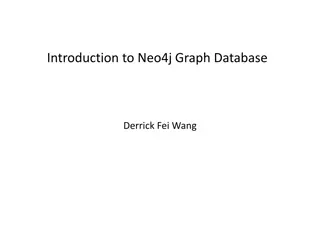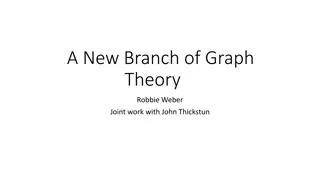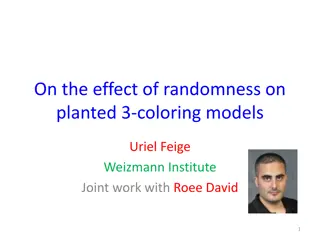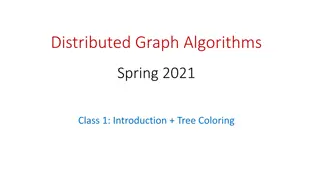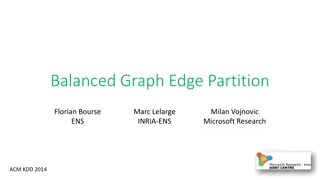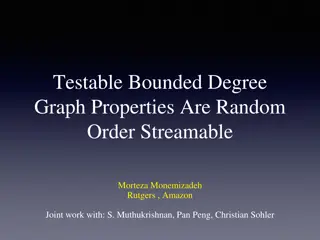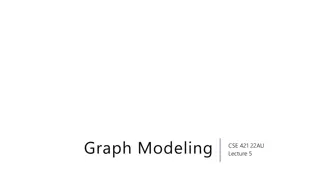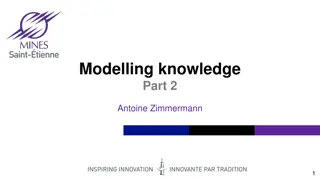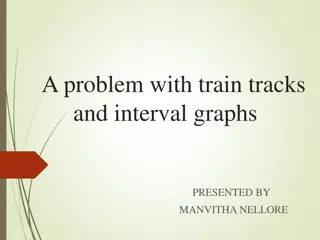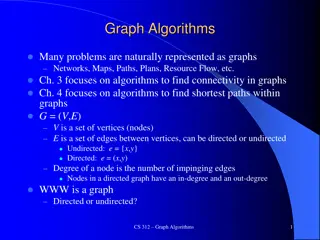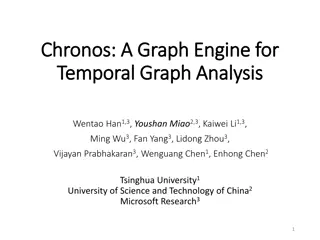Solving Graph Problems: A Comprehensive Guide
Explore various graph problems and solutions, including path finding, connectivity, reachability, cost paths, cycles, trees, spanning trees, isomorphism, and more. Learn about graph search algorithms like BFS and DFS, and their applications.
Download Presentation

Please find below an Image/Link to download the presentation.
The content on the website is provided AS IS for your information and personal use only. It may not be sold, licensed, or shared on other websites without obtaining consent from the author.If you encounter any issues during the download, it is possible that the publisher has removed the file from their server.
You are allowed to download the files provided on this website for personal or commercial use, subject to the condition that they are used lawfully. All files are the property of their respective owners.
The content on the website is provided AS IS for your information and personal use only. It may not be sold, licensed, or shared on other websites without obtaining consent from the author.
E N D
Presentation Transcript
Graph Search Textbook: Sedgewick Part 5 COMP2521 18x1
Talk about lab and assignment
Problems on Graphs What kinds of problems do we want to solve on/via graphs? Is there a simple path from A to B Is the graph fully-connected? Which vertices are reachable from v? (transitive closure) What is the cheapest cost path from v to w? Is there a cycle that passes through all V? (tour) Is there a tree that links all vertices (spanning tree) What is the minimum spanning tree? Are two graphs equivalent ? (isomorphism)
Graph Search We learn about properties of a graph by systematically examining each of its vertices and edges, for example to compute the degree of all vertices, we visit each vertex and count it s edges for path related properties, we have to move from vertex to vertex, along the graphs edges We implement a general graph search algorithms we can use to solve a wide range of graph problems
Simple Path Search Problem: is there a path from vertex v to vertex w ? Approach to solving problem: examine vertices adjacent to v if any of them is w, then we are done otherwise check if there is a path from any of the adjacent vertices repeat looking further and further from v Two different approaches to order of searching: breadth-first search (BFS), depth-first search (DFS)
BFS vs DFS search Is there a path from a to h?
DFS vs BFS DFS and BFS are closely related. BFS implemented via a queue of to-be-visited vertices DFS implemented via a stack of to-be-visited vertices (or recursion) Both approaches ignore some edges and avoid cycles by remembering previously visited vertices.
Exercise: DFS vs BFS Show the DFS order we visit to determine isPath(a,k) Show the BFS order we visit to determine isPath(a,k) Assume neighbours are chosen in alphabetical order
Depth First Search Basic approach to depth-first search: visit and mark current vertex for each neighbour, traverse it recursively Notes: need a mechanism for "marking" vertices in fact, we number them as we visit them (so that we could later trace path through graph)
Depth First Search Implementation notes We use of three global variables: count : counter to remember how many vertices traversed so far pre[] : array saying order in which each vertex was visited (pre stands for preorder) st[] : array storing the predecessor of each vertex (st stands for spanning tree)
DFS Tree The edges traversed in a graph walk form a tree corresponds to the call tree of the recursive DFS function Represents the original graph minus any cycles or alternate paths Each time we visit a vertex we record the previous vertex we came from. If the graph is connected this forms a spanning tree We store this in the st array
DFS 1 0 0 2 2 6 7 6 1 7 5 5 3 4 4 3 // Assume we start with dummy Edge {0,0} // assume we start with count = 0 // pre[v] = -1 for all v // st[v] = -1 for all v (stores the predecessor) // assume adjacency matrix representation void dfsR (Graph g, Edge e) { Vertex i, w = e.w; pre[w] = count++; st[w] = e.v; for (i=0; i < g->V; i++){ if ((g->edges[w][i] == 1) && (pre[i] == -1) dfsR (g, mkEdge(g,w,i)); } } }
DFS 1 0 0 2 2 6 7 6 1 7 5 5 3 4 4 3 0 1 2 3 4 5 6 7 pre 0 7 1 4 3 5 2 6 st 0 7 0 4 6 3 2 4 pre contains the pre-ordering of the vertices
DFS 0 2 0 6 1 7 2 5 3 4 6 4 0 1 2 3 4 5 6 7 pre 0 7 1 4 3 5 2 6 7 3 st 0 7 0 4 6 3 2 4 1 5 The edges traversed in the graph walk form a tree the tree corresponds to the call tree of the depth first search and to the contents of the st array - spanning tree
DFS Forests If a graph is not connected it will produce a spanning forest We call an edge connecting a vertex with an ancestor in the DFS tree that is not its parent a back edge 0 2 back edge 0 2 6 6 4 1 7 5 7 3 3 4 1 5
DFS Traversal Which vertices will be visited during dfs(g): How can we ensure that all vertices are visited?
Graph Search We need to make sure that we visit every connected component: void dfSearch (Graph g) { int v; count = 0; pre = malloc (sizeof (int) * g->nV)); st = malloc(sizeof (int) * g->nV)); for (v = 0; v < g->nV; v++){ pre[v] = -1; st[v] = -1; } for (v = 0; v < g->V; v++) { if (pre[v] == -1) dfsR (g, mkEdge(g,v,v)); } }
Exercise Modify the dfsR function we wrote for the adjacency matrix for an adjacency list representation
Graph Search The time complexity of the search algorithm depends on the representation. Adjacency matrix O( V2 ) Adjacency list O ( V + E ) If the graph is dense, E will be O(V2) So overall it will be O(V2) or O(E) If the graph is sparse, E will be O(V) so overall it will be O(V)
Exercise: DFS Trace the execution of dfs(g,0) on: Assume when there is a choice you choose the vertex with the lower id
Exercise: DFS Trace the execution of dfs(g,0) assuming when there is a choice you choose the vertex with the lower id What if we were using DFS to search for a path from 0..5? We would get 0-1-2-3-4-5.
Exercise: DFS Show the final state of thepre and st arrays afterdfs(g,0): pre st
Exercise Assuming you have a global st array that has just been used in a DFS, write a function to print the path from one given vertex to another. void printPath(Vertex v1, Vertex v2);
DFS: Cycle Detection Cycle detection: does a given graph have any cycles? If and only if the DFS graph has back edges, it contains cycles We can easily detect this in the DFS search:
DFS: Cycle Detection We are only checking for the existence of cycle, we are not returning it //Return 1 if there is a cycle int hasCycle (Graph g, Edge e) { int i, w = e.w; pre[w] = count++; st[w] = e.v; for (i=0; i < g->V; i++){ if ((g->edges[w][i] == 1) && (pre[i] == -1)) { if(hasCycle (g, mkEdge(g,w,i))) return 1; } else if( (g->edges[w][i] == 1) && i != e.v){ //if it is not the predecessor return 1; } } return 0; }
DFS : Connectivity Each vertex belongs to a connected component Using a dfs we can set up the array cc to indicate which component contains each vertex cc
DFS: Connectivity Maintain an extra array cc for connected components void connectedComponents (Graph g) { int v; count = 0; ccCount = 0; pre = malloc (g->nV *sizeof (int)); cc = malloc (g->nV *sizeof (int)); st = malloc (g->nV *sizeof (int)); for (v = 0; v < g->nV; v++) { pre[v] = -1; st[v] = -1; cc[v] = -1; } for (v = 0; v < g->V; v++) { if (pre[v] == -1) { connectedR (g, mkEdge(g,v,v)); ccCount++; } } } void connectedR (Graph g, Edge e) { int i, w = e.w; pre[w] = count++; st[w] = e.v; cc[w] = ccCount; for (i=0; i < g->V; i++){ if ((g->edges[currV][i] == 1) && (pre[i] == -1)) { dfsR (g, mkEdge(g,w,i)); } } }
Non-Recursive DFS We can use a stack instead of recursion: void dfs (Graph g, Edge e) { int i; Stack s = newStack(); StackPush (s,e); while (!StackIsEmpty(s)) { e = StackPop(s); if (pre[e.w] == -1) { pre[e.w] = count++; st[e.w] = e.v; for (i = 0; i < g->nV; i++) { if ((g->edges[e.w][i] == 1)&& (pre[i] == -1)) { StackPush (s,mkEdge(g,e.w,i)); } } } } }
BFS DFS does NOT help us with the problem of finding the shortest path between 2 vertices To find the shortest path between v and any vertex w we visit all the vertices adjacent to v (distance 1) then all the vertices adjacent to those we visited in the first step (distance 2) etc 0 2 0 6 7 2 3 1 7 5 1 5 6 4 3 4
Breadth-First Search We can simply replace the stack with a queue in the non-recursive implementation of DFS to get BFS void bfs (Graph g, Edge e) { int i; Queue q = newQueue(); QueueJoin(q,e); while (!QueueIsEmpty(q)) { e = QueueLeave(q); if(pre[e.w] == -1){ pre[e.w] = count++; st[e.w] = e.v; for (i = 0; i < g->nV; i++){ if ((g->edges[e.w][i] != 0)&& (pre[i] == -1)) { QueueJoin (q,mkEdge(g,e.w,i)); } } } } }
Improved BFS We can mark vertices as visited as we put them on the queue instead of when they leave the queue. Queue will then have at most V entries void bfs (Graph g, Edge e) { int i; Queue q = newQueue(); QueueJoin (q,e); pre[e.w] = count++; st[e.w] = e.v; while (!QueueIsEmpty(q)) { e = QueueLeave(q); for (i = 0; i < g->V; i++) { if ((g->edges[e.w][i] != 0)&&(pre[i] == -1)) { QueueJoin (q,mkEdge(g,e.w,i)); pre[i] = count++; st[i] = e.w; } } } }
Exercise: BFS Show the final state of the pre and st arrays after bfs(g,0): Write code to print out the shortest path from 0 to a given vertex v using the st array.
BFS Just like DFS, the time complexity of the search algorithm depends on the representation. Adjacency matrix O( V2 ) Adjacency list O( V + E )
BFS We can do BFS for every node as root node, and store the resulting spanning trees in a V x V matrix to store all the shortest paths between any two vertices To store and calculate these spanning trees, we need memory proportional to V * V Then, we can return path length in constant time and the path in time proportional to the path length




